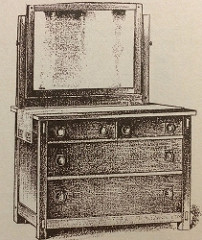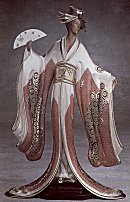Description: Dresser
Dimensions: 45" Wide x 22" Deep x 69" High, Mirror 34" Wide x 28" High
Info: Mission style furniture is characterized by broad, straight horizontal and vertical lines . The furniture is usually comprised of oak with a distinct dark finish. The designs are simple and elegant with little embellishment, illustrating the simplicity and durability of the pieces.
Dressers are adorned with multiple drawers and copper or iron handles. Some designs will include a plain french mirror. Some dressers deviate from traditional mission style designs with bowed sides and curved aprons.
Dressers are adorned with multiple drawers and copper or iron handles. Some designs will include a plain french mirror. Some dressers deviate from traditional mission style designs with bowed sides and curved aprons.
History: The "Life-Time Furniture Co." ("Grand Rapids Bookcase and Chair Co.") was founded in 1911 by A. A. Barber through a merger of the Grand Rapids Bookcase Co. and the Barker Brothers Chair Co. The company operated out of Hastings and Grand Rapids, Michigan creating furniture that influenced the Arts and Crafts movement in North America.
The company is best known for its Cloister style which greatly influenced the development of the designs of Mission style furniture in the early 20th Century. The Cloister style is distinct from other popular Mission style furniture at the time, including the works of Gustav Stickley. Cloister style furniture is known for its simple pieces with massive, straight lines, occasionally broken by arched front rails. A later design changed the stiles and legs of the furniture and was marketed as the Jacobean style in 1913. Finally the Life-Time Furniture style was introduced which slenderized the massive lines associated with previous designs but still incorporated arches and curved brackets of the original Cloister style.
The company advertised Monks and Southwestern Mission Churches in its catalog and the furniture was marked with a "Life-Time Furniture" label. These trademarks are better known to collectors of Arts and Crafts Mission Furniture than the merged company name.
The company operated until it was merged into the John Widdicomb Company in 1956. Soon after it was purchased by Medallion Ltd. and operated as Hastings Corporation until it finally closed in 1975.
The company is best known for its Cloister style which greatly influenced the development of the designs of Mission style furniture in the early 20th Century. The Cloister style is distinct from other popular Mission style furniture at the time, including the works of Gustav Stickley. Cloister style furniture is known for its simple pieces with massive, straight lines, occasionally broken by arched front rails. A later design changed the stiles and legs of the furniture and was marketed as the Jacobean style in 1913. Finally the Life-Time Furniture style was introduced which slenderized the massive lines associated with previous designs but still incorporated arches and curved brackets of the original Cloister style.
The company advertised Monks and Southwestern Mission Churches in its catalog and the furniture was marked with a "Life-Time Furniture" label. These trademarks are better known to collectors of Arts and Crafts Mission Furniture than the merged company name.
The company operated until it was merged into the John Widdicomb Company in 1956. Soon after it was purchased by Medallion Ltd. and operated as Hastings Corporation until it finally closed in 1975.
Item created by: nmwhite997 on 2016-05-31 11:04:18. Last edited by gdm on 2018-01-09 10:54:59
If you see errors or missing data in this entry, please feel free to log in and edit it. Anyone with a Gmail account can log in instantly.
If you see errors or missing data in this entry, please feel free to log in and edit it. Anyone with a Gmail account can log in instantly.







